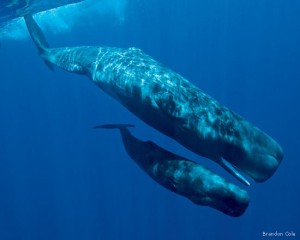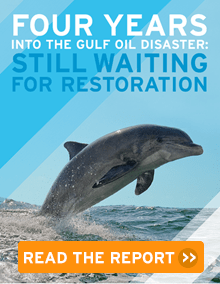We have much more to do and your continued support is needed now more than ever.
Millions of Gallons of BP Oil “Found”—on Gulf Floor

Not quite. Scientists with the University of California have just released an analysis of data from this federal study. It describes a “bathtub ring” of oil the size of Rhode Island on the floor of the Gulf of Mexico.
The oil forms what lead scientist David Valentine calls “a smokingly clear signal, like a bulls-eye” around the destroyed well. Oil levels inside this ring are as much as 10,000 times higher than those found elsewhere in the Gulf.
As large as the area is, it only represents a fraction of the oil thought to be trapped deep in the Gulf. The authors suggest in the Proceedings of the National Academy of Sciences that “a significant quantity of oil was deposited on the ocean floor outside this area but so far has evaded detection.”
The wildlife implications of the oil remaining on the floor of the Gulf are still largely unknown. The authors found hotspots of oil in close proximity to deep-sea corals described as having been affected by the oil in previous studies. The National Science Foundation reports:
According to the researchers, the data support the previously disputed finding that these corals were damaged by the Deepwater Horizon spill.
“The evidence is becoming clear that oily particles were raining down around these deep sea corals, which provides a compelling explanation for the injury they suffered,” said Valentine.
Previous underwater explorations to the area around the wellhead essentially corroborate these recent, more systematic findings. In 2010 a remotely-operated vehicle found numerous dead organisms and oil that had not degraded. In 2014, a follow-up operation found that much of the oil remains on the floor of the Gulf, becoming “part of the geological record.”
 But more than four years after the disaster, comprehensive restoration of the Gulf has not yet gotten underway. A federal judge recently found BP ‘grossly negligent,’ but the company is drawing out the legal process to delay paying the billions it owes.
But more than four years after the disaster, comprehensive restoration of the Gulf has not yet gotten underway. A federal judge recently found BP ‘grossly negligent,’ but the company is drawing out the legal process to delay paying the billions it owes.
While BP stalls in court, Gulf wildlife are still struggling.
Blue crab and oyster harvests are down, dolphins in a heavily-oiled area of Louisiana have symptoms of oil exposure, scientists have documented impacts to red snapper and a chemical in oil from the Deepwater Horizon damages heart function in fish.





















